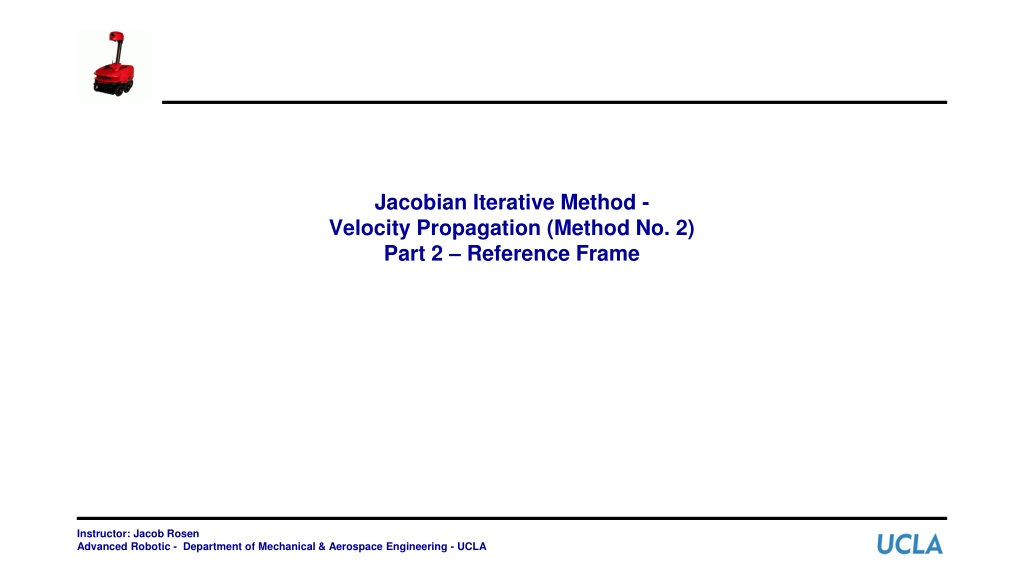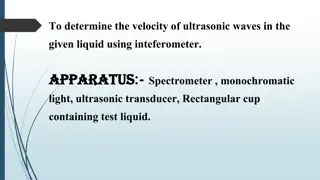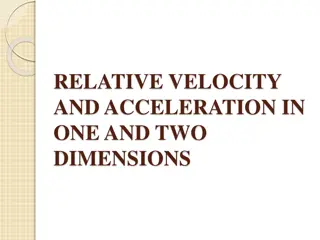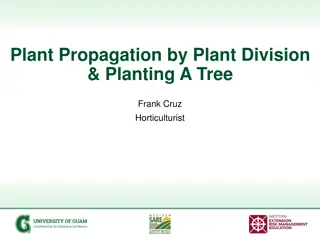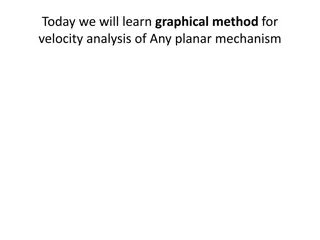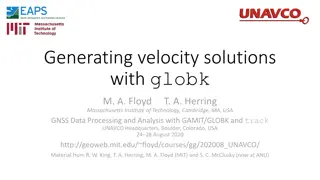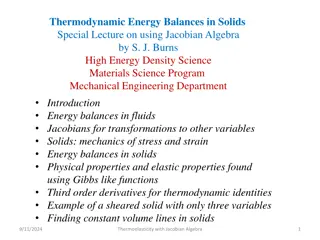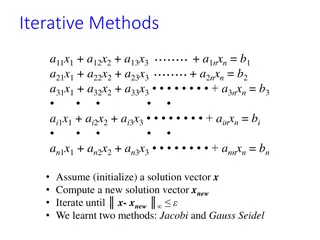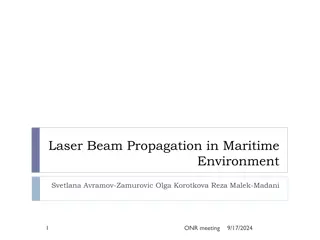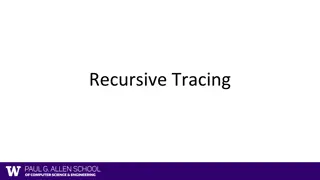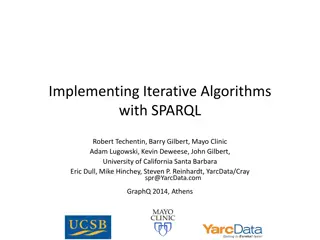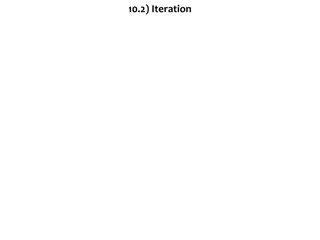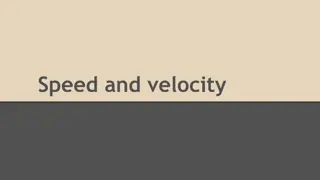Understanding Jacobian Iterative Method for Velocity Propagation
Explore the Jacobian Matrix and its applications in velocity propagation for robotics. Learn about recursive expressions, differentiation methods, and handling linear and angular velocities in different frames of reference. Delve into the dynamics of a 3R robot example and grasp the concept of Jacobian expression notation.
Download Presentation

Please find below an Image/Link to download the presentation.
The content on the website is provided AS IS for your information and personal use only. It may not be sold, licensed, or shared on other websites without obtaining consent from the author. Download presentation by click this link. If you encounter any issues during the download, it is possible that the publisher has removed the file from their server.
E N D
Presentation Transcript
Jacobian Iterative Method - Velocity Propagation (Method No. 2) Part 2 Reference Frame Instructor: Jacob Rosen Advanced Robotic - Department of Mechanical & Aerospace Engineering - UCLA
Jacobian Matrix - Derivation Methods Explicit Method Iterative Methods Recursive Equations Velocity Propagation Base to EE (Method 2) Force/Torque Propagation EE to Base (Method 3) Differentiation the Forward Kinematics Eqs. (Method 1) Jacobian Matrix Instructor: Jacob Rosen Advanced Robotic - Department of Mechanical & Aerospace Engineering - UCLA
Jacobian: Velocity propagation The recursive expressions for the adjacent joint linear and angular velocities describe a relationship between the joint angle rates ( ) and the transnational and rotational velocities of the end effector (?): 0 0 ?+1? ???+ ?+1??+1= ? ??+1 0 0 ?+1? ?+1??+1= ?? ???+1+??? + ? ??+1 Instructor: Jacob Rosen Advanced Robotic - Department of Mechanical & Aerospace Engineering - UCLA
Angular and Linear Velocities - 3R Robot - Example The velocity propagation method provided us the linear and angular velocities of the end effector differentiated with respect to the base frame {0} but expressed in the end effector frame frame {4} ?3 ) ?2+ ?3 ?2 ?23 ?1 ?23 ?1 ?2+ ?3 ?2 ?2 4 0?4 4?4= ?3 ?2 + ?3 ?3 ) ?1 (?2 ( ?1 ?3 ?23 4 0 4 4?4= We wish to express the linear and angular velocities in the same base that the were differentiated i.e frame {0} 0 0 0?4 0 4 0?4 ?4 0?4 ?4 Instructor: Jacob Rosen Advanced Robotic - Department of Mechanical & Aerospace Engineering - UCLA
Jacobian Expression Frame of Reference Frame Notation Instructor: Jacob Rosen Advanced Robotic - Department of Mechanical & Aerospace Engineering - UCLA
Jacobian: Velocity propagation The recursive expressions for the adjacent joint linear and angular velocities defines the Jacobian in the end effector frame {N} ?? = ??( ) This equation can be expanded to: ?1 ?2 ?3 ?4 ?5 ?6 ??? ?? ?? ?? ?? ?? ? ? ?? ?? ?? ??[?] = ?( ) ?? = = = Instructor: Jacob Rosen Advanced Robotic - Department of Mechanical & Aerospace Engineering - UCLA
Jacobian - 3R - Example The linear angular velocities of the end effector (N=4) ?3 ) ?2+ ?3 ?2 ?2 ?2 4?4 ?3 ?2 + ?3 ?3 ) ?1 = (?2 ( ?1 ?3 ?23 ?23 ?23 ?2+ ?3 ?1 ?1 4?4= Instructor: Jacob Rosen Advanced Robotic - Department of Mechanical & Aerospace Engineering - UCLA
Jacobian - 3R - Example Re-arranged to previous two terms gives an expression that encapsulates 4? = 4?( ) ?3 ) ?2+ ?3 ?2 ?23 ?1 ?23 ?1 ?2+ ?3 ?2 ?2 ?1 ?2 ?3 ?4 ?5 ?6 4?? ?? ?? ?? ?? ?? ?3 ?2 + ?3 ?3 ) ?1 (?2 ( ?1 4 ?3 ?23 4?4 4?4 ?( ) 4? = = = = We can now factor out the joint velocities vector ? = [ ?1 ?2 ?3]? from the above vector to formulate the Jacobian matrix 4?( ) Instructor: Jacob Rosen Advanced Robotic - Department of Mechanical & Aerospace Engineering - UCLA
Jacobian - 3R - Example 4? = 4?( ) 4 ?3 + ?3 0 0 0 1 4?? ?? ?? ?? ?? ?? 0 0 ?2 0 ?3 0 0 0 1 ?3 ?2 ?1 ?2 ?3 ?2 ?23 ?23 0 ?3 ?23 ?2 ?1 = ??? ??? The equations for and are always a linear combination of the joint velocities, so they can always be used to find the 6xN Jacobian matrix ( ) for any robot manipulator. Note that the Jacobian matrix is expressed in frame {4} Problems Dimensions of the Jacobian (Example: Current 6x3 reduce to 3x3 ) Frame of Reference / Representation (Example: Frame 4 Move to Frame 0) ?? ? Instructor: Jacob Rosen Advanced Robotic - Department of Mechanical & Aerospace Engineering - UCLA
Jacobian Expression Frame of Reference / Representation Instructor: Jacob Rosen Advanced Robotic - Department of Mechanical & Aerospace Engineering - UCLA
Jacobian: Frame of Representation Using the velocity propagation method we expressed the relationship between the velocity of the robot end effector measured relative to the robot base frame {0} and expressed in the end effector frame {N}. ?? = ??( ) Occasionally, it may be desirable to express (represent) the end effector velocities in another frame (e.g. frame {0}, in which case we will need a method to provide the transformation. 0? = 0?( ) Instructor: Jacob Rosen Advanced Robotic - Department of Mechanical & Aerospace Engineering - UCLA
Jacobian: Frame of Representation There are two methods to change the references frame (frame of representation) of the Jacobian Matrix Method 1 (Before The Jacobian Matrix Is Formulated) Transforming the linear and angular velocities to the new frame prior to formulating the Jabobian matrix. Method 2 (Before The Jacobian Matrix Is Formulated) Transforming the Jacobian matrix from it existing frame to the new frame after it was formulated. Instructor: Jacob Rosen Advanced Robotic - Department of Mechanical & Aerospace Engineering - UCLA
Jacobian Expression Frame of Reference Method No. 1 Transform the Velocity Vectors Instructor: Jacob Rosen Advanced Robotic - Department of Mechanical & Aerospace Engineering - UCLA
Jacobian: Frame of Representation Method 1 Consider the velocities in a different frame {B} ??? ??? ?? = We may use the rotation matrix to find the velocities in frame {A}: ?? ??? ??? ??? ??? ? ?? ?? = = ? Instructor: Jacob Rosen Advanced Robotic - Department of Mechanical & Aerospace Engineering - UCLA
Jacobian: Frame of Representation Method 1 Example: Analyzing a 6 DOF manipulator while utilizing velocity propagation method results in an expressing the end effector (frame 6) linear and angular velocities. 6?6 6?6 6? = Using the forward kinematics formulation the rotation matrix from frame 0 to frame 6 can be defined as 0? 0?6??? 6 4?6 0? =1 0?2 1?3 2?4 3?5 5? = 6 0 0 0 1 The linear and angular velocities can than be expressed in frame 0 prior to extracting the Jacobian in frame 0 0? 6?6 6?6 0?6 0?6 6 0? 0? = = 6 Instructor: Jacob Rosen Advanced Robotic - Department of Mechanical & Aerospace Engineering - UCLA
Jacobian Expression Frame of Reference Method No. 2 Transform the Jacobian Matrix Instructor: Jacob Rosen Advanced Robotic - Department of Mechanical & Aerospace Engineering - UCLA
Jacobian: Frame of Representation Method 2 ??? It is possible to define a Jacobian transformation matrix that can transform the Jacobian from frame B to frame A ? ?????( ) ?? = ??( ) =? ??? The Jacobian rotation matrix is given by ? 0 0 0 0 0 0 0 0 0 ?? ? ???= ? 0 0 0 0 0 0 0 0 0 ?? ? Instructor: Jacob Rosen Advanced Robotic - Department of Mechanical & Aerospace Engineering - UCLA
Jacobian: Frame of Representation or equivalently, 0 0 0 0 0 0 0 0 0 ?? ? ??( ) = ??( ) 0 0 0 0 0 0 0 0 0 ?? ? Instructor: Jacob Rosen Advanced Robotic - MAE 263B - Department of Mechanical & Aerospace Engineering - UCLA
Jacobian: Frame of Representation - 3R Example 0??4?( ) 0?( ) =4 4 0 2 3 0 L L s 0 0 0 1 23 1 23 1 c 0 0 0 c c c s s 4 R + 0 0 c 2 3 3 3 L c L 0 0 0 1 s 23 1 23 1 0 0 0 s c s s 1 2 s 2 3 23 0 0 L L L c 0 0 0 23 23 0 0 0 c 0 c ( ) ( ) = = 0 4 J J 0 0 0 0 0 0 1 23 1 23 1 c c c s s 23 0 0 4 R 0 0 0 0 0 0 0 1 s 23 1 23 1 s c s s 23 0 0 c 0 0 0 0 0 0 23 23 0 c 0 1 1 The rotation matrix ( ) can be calculated base on the direct kinematics given by 4 0? 0? 0?4??? 4 0? =1 0?2 1?3 2?4 3? = 4 0 0 0 1 Instructor: Jacob Rosen Advanced Robotic - Department of Mechanical & Aerospace Engineering - UCLA
Jacobian Methods of Derivation & the Corresponding Reference Frame Summary Method Jacobian Matrix Reference Frame Transformation to Base Frame (Frame 0) Explicit (Diff. the Forward Kinematic Eq.) None 0?? Iterative Velocity Eq. Transform Method 1: 0? 0??=? ??? 0? 0??=? ??? ??? Transform Method 2: 0? 0 0 0? ? 0??? = ???? ? Iterative Force Eq. Transpose ?]? ???= [ ??? ? ??? Transform 0? 0 0 0? ? 0??? = ???? ? Instructor: Jacob Rosen Advanced Robotic - MAE 263B - Department of Mechanical & Aerospace Engineering - UCLA
Dimension of the Jacobian Expression Dimension Reduction Instructor: Jacob Rosen Advanced Robotic - Department of Mechanical & Aerospace Engineering - UCLA
Inverse Jacobian - Reduced Jacobian Problem When the number of joints (N) is less than 6, the manipulator does not have the necessary degrees of freedom to achieve independent control of all six velocities components. 4?? ?? ?? ?? ?? ?? 4? = Solution We can reduce the number of rows in the original Jacobian to describe a reduced Cartesian vector. Instructor: Jacob Rosen Advanced Robotic - Department of Mechanical & Aerospace Engineering - UCLA
Jacobian: Reduced Jacobian - 3R Example Matrix Reduction - Option 1 4 ?3 + ?3 0 0 0 1 4?? ?? ?? ?? ?? ?? 0 0 ?2 0 ?3 0 0 0 1 ?3 ?2 ?1 ?2 ?3 ?2 ?23 ?23 0 ?3 ?23 ?2 ?1 = Column of zeroes The determinate is equal to zero Only two out of the three variables can be independently specified Instructor: Jacob Rosen Advanced Robotic - Department of Mechanical & Aerospace Engineering - UCLA
Jacobian: Reduced Jacobian - 3R Example Matrix Reduction - Option 2 4 ?3 + ?3 0 0 0 1 4?? ?? ?? ?? ?? ?? 0 0 ?2 0 ?3 0 0 0 1 ?3 ?2 ?1 ?2 ?3 ?2 ?23 ?23 0 ?3 ?23 ?2 ?1 = Two columns of zeroes The determinate is equal to zero Only one out of the three variables can be independently specified Instructor: Jacob Rosen Advanced Robotic - Department of Mechanical & Aerospace Engineering - UCLA
Jacobian: Reduced Jacobian - 3R Example Matrix Reduction - Option 3 4 ?3 + ?3 0 0 0 1 4?? ?? ?? ?? ?? ?? 0 0 ?2 0 ?3 0 0 0 1 ?3 ?2 ?1 ?2 ?3 ?2 ?23 ?23 0 ?3 ?23 ?2 ?1 = The resulting reduced Jacobian will be square (the number of independent rows in the Jacobian are equal to the number of unknown variables) and can be inverted unless in a singular configuration. Instructor: Jacob Rosen Advanced Robotic - Department of Mechanical & Aerospace Engineering - UCLA
Jacobian: Singular Configuration - 3R Example 0 0 ?2?3 0 ?3 0 4??? = ?2?3 + ?3 0 ?1 ?2?2 ?3?23 Instructor: Jacob Rosen Advanced Robotic - Department of Mechanical & Aerospace Engineering - UCLA
